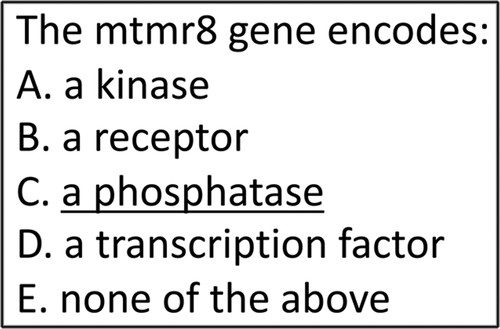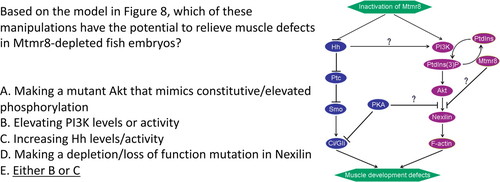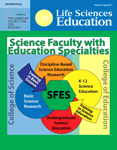The Benefits of Using Clickers in Small-Enrollment Seminar-Style Biology Courses
Abstract
Although the use of clickers and peer discussion is becoming common in large-lecture undergraduate biology courses, their use is limited in small-enrollment seminar-style courses. To investigate whether facilitating peer discussion with clickers would add value to a small-enrollment seminar-style course, we evaluated their usefulness in an 11-student Embryology course at the University of Colorado, Boulder. Student performance data, observations of peer discussion, and interviews with students revealed that adding clickers to a small-enrollment course 1) increases the chance students will do the required reading before class, 2) helps the instructor engage all students in the class, and 3) gives students a focused opportunity to share thinking and to learn from their peers.
INTRODUCTION
The utility of clickers and peer discussion in large-lecture introductory biology courses is well established. Typically, instructors pose multiple-choice questions requiring application of a recently presented concept at several points during a class. In one commonly used approach called peer instruction, students first answer a concept question individually, discuss the question with their peers, and then revote before the answer to the question is revealed (Mazur, 1997). The instructor then displays histograms of student responses, which give immediate feedback to both instructors and students on how well a concept is understood.
Several studies have shown that students enjoy using clickers, feel that this form of interactive engagement is useful for their learning, and learn from discussing questions with their peers (e.g., Knight and Wood, 2005; Caldwell, 2007; Preszler et al., 2007; Smith et al., 2009). However, despite the evidence about the positive impact of clickers in biology courses, we frequently encounter faculty members who say that there is no benefit to using them in small-enrollment (fewer than 25 students) seminar-style biology courses. When asked why, they commonly say that in small-enrollment courses the instructor already spends a lot of time interacting with students and asking questions. In short, these instructors feel that adding clickers to peer discussion would not add value to the way they teach these types of courses. However, we considered the possibility that clickers offer the additional benefit of instantaneous feedback, while allowing individuals to maintain anonymity. The latter benefit may create a situation that is conducive to encouraging all students to participate in a course, even if it is a small-enrollment course.
To find out if this perception is correct, we investigated adding clickers to peer discussion in an 11-student upper-division Embryology course at the University of Colorado, Boulder (course demographics in Table 1). Broad learning goals for this course are listed in Table 2. All of the students in this course had experience using clickers in their large-enrollment lower-division biology courses, but this was their first time using clickers in a small-enrollment upper-division biology course.
| Category | Demographic information |
|---|---|
| Gender | 45% male, 55% female |
| Year in college | 18% junior, 82% senior |
| Major | 91% molecular biology, 9% biochemistry |
| Grade distribution | 63.6% A, 18.2% B, 9.1% C, 9.1% pass |
| At the end of this course, students should be able to explain fundamental embryology experiments and be exposed to current questions in the field. In addition, students should be able to: | |
| Communicate knowledge through writing and speaking. | Prepare a presentation that summarizes findings in a journal article. |
| Write a grant proposal that has the potential to be funded by an undergraduate granting entity. | |
| Discuss findings from a journal article with their peers. | |
| Explain how experimental evidence is developed. | Interpret and draw conclusions from primary research data, often in graphical and pictorial form. |
| Judge the validity of conclusions found in journal articles. | |
| Integrate and apply knowledge from previous core biology courses to understanding the techniques used in a journal article. | |
| Distinguish between and justify the use of different possible experimental approaches. | |
| Apply known methods to new situations. | Predict the results of future experiments based on information learned in a journal article. |
| Identify unsolved problems in the field. | |
THE USE OF CLICKERS AND PEER DISCUSSION IN A SMALL-ENROLLMENT COURSE
In this Embryology course, each student gave two presentations, one on a classic embryology paper chosen by the instructor and another on a recent paper of their choosing. (The distribution of grading points for this course is described in Table 3, and a list of all the papers presented is given in Supplemental Material A). The students prepared PowerPoint slides for use with their presentation and had the option to have it critiqued by the instructor (T.T.S.) ahead of time. The morning before each student's presentation, the instructor added clicker questions to the PowerPoint slides. The students, including the student presenter, did not see the clicker questions ahead of time.
| Percent | |
|---|---|
| Clicker questions (reading quiz and application questions) | 30 |
| Oral presentation I | 15 |
| Oral presentation II | 15 |
| Asking questions during presentations (participation points) | 5 |
| Grant proposal draft | 10 |
| Final grant proposal | 20 |
| Class surveys (participation points) | 5 |
Two types of questions were added to the student presentations. The first type (hereafter called “reading quiz questions”) consisted of mostly fact-based questions to determine whether students read the paper before class. An example of a reading quiz question is shown in Figure 1. Students answered these clicker questions individually without peer discussion and received a point only if they got the answer correct. The reading quiz questions were asked throughout the presentation and were designed to cover the key methods and results in the article.

Figure 1: Example of a reading quiz question from a paper by Mei et al. (2009). The correct answer is underlined.
The second question type (hereafter called “application questions”) asked students to apply what they learned from the paper and presentation. An example of an application question is shown in Figure 2. The application questions were asked at the end of the presentation. Students answered the application questions individually, discussed the answer with their peers, and then answered the same question again. The histograms of student responses were not revealed to students until after they answered the questions a second time, because when class responses to clicker questions are shown, students are inclined to move to the most common answer, which likely diminishes the value of peer discussion (Perez et al., 2010). Students received participation points regardless of their answers for the application questions. Participation points were awarded for these types of questions because the instructor wanted to emphasize discussion, scientific argument, and articulation of thought over just getting the right answer. A typical presentation included four reading quiz questions and two application questions.

Figure 2: Example of an application question from a paper by Mei et al. (2009). The correct answer is underlined.
During the class, students and the instructor sat around a single large table. For the peer-discussion portion of the application questions, our observations revealed that the 11 students tended to divide into two groups based on where they were sitting. A typical discussion would begin with one student saying what he or she answered and then the other students in the group would say if they agreed or disagreed with the answer. Even if students all agreed on a particular answer, they would often discuss why the other answers were incorrect. A transcript of a student discussion is given in Supplemental Material B. The instructor removed herself from the peer discussion as much as possible and would ask clarifying questions only if the students started to go off track with their discussion.
STUDENT REACTIONS TO USING CLICKERS IN A SMALL-ENROLLMENT COURSE
In addition to examining student performance results and observing peer discussion, a researcher not associated with the course (M.K.S.) interviewed 8 of the 11 students about their experience using clickers in this small-enrollment course. The interview results revealed that clickers added value to this embryology course in three important ways.
First, all of the interviewed students stated that adding clicker questions to the student presentations encouraged them to read the papers before class. As one student admitted, “I doubt I would have read the papers if there were no clicker questions, or at least I would have tried to get by without reading them.” The average score on the individually answered reading quiz questions was 69% (SEM = 3.21%, n = 79 questions). Although that may not seem impressive at first, some studies have shown that only 20–30% of the students read assignments before class when requested by their instructor (reviewed by Hobson, 2004). Also, several students felt that the way they read scientific papers improved because of the clicker questions. For example, one student said: “As I am reading the paper I think, what will Tin Tin ask about? It forces me to think about the organism used, the type of experiment, etc.”
Of course, there are other ways to encourage students to read papers before class. During the previous five times teaching this class, the instructor used preclass reading quizzes, which consisted of factual questions only. However, the instructor observed that, even if students read the paper and were able to answer quiz questions correctly, they often tuned out the subsequent student presentation. In dispersing the reading quiz questions throughout the presentation with the facilitation of clickers, the instructor hypothesized that students would remain more engaged. During the interviews, seven of the eight students commented that having the clicker questions helped them pay attention to the student presentations. According to one student: “I would still read the papers in other classes but for this class I highlight key things and keep the paper open while the presentation is going on, so I can keep track of what is going on.”
Second, students felt that asking clicker questions creates an environment where every student, not just one or two, thinks through and answers each question being asked. In many small-enrollment biology courses, instructors ask open-ended questions and call on a student to answer. However, even with such efforts, there is potential for the remaining students to be left out of the discussion, especially if they are not confident about the answer. During the interviews, students talked about how they liked contributing to the class even when they were not speaking. Three such descriptions follow:
If we didn't have clicker questions then 2–3 people would dominate the conversation and Tin Tin might think because they understand what is going on, we all understand it. Clickers give people a voice, even if it is not a verbal one.
If you didn't have clickers and Tin Tin asked open-ended questions to us, most of the time I would just think: “well I do not know” and just sit there and listen to what she says is correct.
Clickers force students to answer and discuss. You avoid that blank stare after the instructor asks you to answer questions. They get students thinking and their brains moving.
Finally, the application questions gave students an opportunity to articulate their thinking and learn from their peers during class. When students voted individually on the application questions, the average percent correct equaled 53.9% (SEM ±4.6, n = 22 questions). But after peer discussion, the average percent correct increased to 91.5% (SEM ±3.7). Therefore, just as has been reported in large-enrollment biology courses (e.g., Knight and Wood, 2005; Smith et al., 2009), peer discussion in small-enrollment courses also improves student performance on clicker questions. One student described the peer discussion experience this way: “It is like going to a coffee shop and talking about science over coffee. I like hearing what my classmates think and they often bring up something I didn't think of. We work together as a whole to figure out the answer.”
While all eight of the students we interviewed thought that clickers were a useful learning tool in small-enrollment courses, five of the eight students mentioned suggestions for improving their use. First, students wanted to have meet-and-greet time during the first week of class, so they could feel more comfortable talking with each other. Second, students expressed that they wanted a chance to write some of their own clicker questions. They thought that writing a subset of the clicker questions sounded like a lot of fun and would help them organize their presentation.
CONCLUSIONS
The performance, observation, and interview data provide encouraging information for instructors who are considering using clickers in their small-enrollment seminar-style biology courses. Importantly, adding clicker use to peer discussion enhanced a small-enrollment biology course by increasing the chance students will read before class, helping the instructor engage all students, and giving students a focused opportunity to share thinking and to learn from their peers. There are many future research questions that can be asked regarding the use of clickers in small-enrollment settings. For example, do students who have not used clickers in previous courses find that clickers are an effective tool in a small lecture setting? Are there other small-enrollment settings such as laboratory meetings and departmental seminars where clickers could be an effective tool for engaging the audience? For instructors interested in including in-class concept questions in their courses, several resources are available at http://STEMclickers.colorado.edu.
INSTITUTIONAL REVIEW BOARD (IRB) PROTOCOLS
Approval to evaluate student clicker responses (exempt status, Protocol No. 0108.9) and interview students (expedited status, Protocol No. 0603.08) was granted by the Institutional Review Board, University of Colorado, Boulder.
ACKNOWLEDGMENTS
We thank the Science Education Initiative at the University of Colorado, Boulder, for full support of M.K.S. and partial support of C.T. We also thank Jenny Knight, Carl Wieman, and Kathy Perkins for intellectual support and Bill Wood for his comments on the manuscript.



